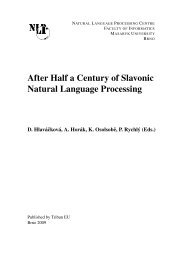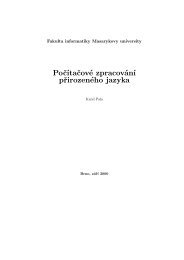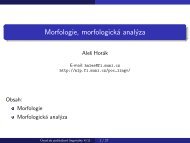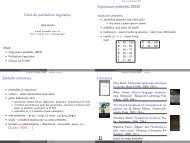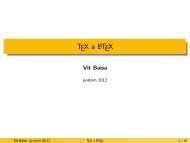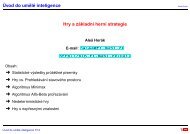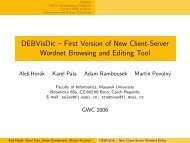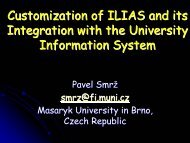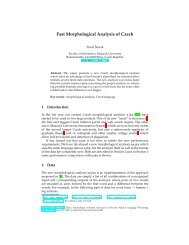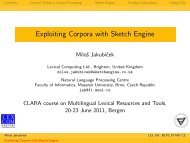GATE: A Unicode-based Infrastructure for Multilingual Information ...
GATE: A Unicode-based Infrastructure for Multilingual Information ...
GATE: A Unicode-based Infrastructure for Multilingual Information ...
Create successful ePaper yourself
Turn your PDF publications into a flip-book with our unique Google optimized e-Paper software.
Figure 1: The GUK <strong>Unicode</strong> editor using a Korean<br />
virtual keyboard.<br />
ing (or charset), in order to be saved into or read<br />
from a file. There are many different encodings<br />
used worldwide, some of them designed <strong>for</strong> a particular<br />
language, others covering the entire range<br />
of characters defined by <strong>Unicode</strong>. <strong>GATE</strong> uses the<br />
facilities provided by Java and so it has access to<br />
over 100 different encodings including the most<br />
popular local ones, such as ISO 8859-1 in Western<br />
countries or ISO-8859-9 in Eastern Europe,<br />
and some <strong>Unicode</strong> ones e.g. UTF-8 or UTF-16.<br />
Once processed, the documents can also be saved<br />
back to their original <strong>for</strong>mat and encoding.<br />
Apart from being able to read several character<br />
encodings, <strong>GATE</strong> supports a range of popular file<br />
<strong>for</strong>mats such as HTML, XML, email, some types<br />
of SGML and RTF.<br />
Another important aspect is displaying and<br />
editing multilingual documents. <strong>GATE</strong> uses<br />
largely the Java <strong>Unicode</strong> support <strong>for</strong> displaying<br />
multilingual documents. Editing multilingual<br />
documents (and also language-specific grammars,<br />
gazetteer lists, etc) is provided by GUK – <strong>GATE</strong>’s<br />
<strong>Unicode</strong> Kit. GUK provides input methods <strong>for</strong> a<br />
large number of languages (see Figure 1), allows<br />
the definition of new ones, and also provides a<br />
<strong>Unicode</strong>-<strong>based</strong> text editor.<br />
So far <strong>GATE</strong> has been used successfully to<br />
create corpora and process documents in a wide<br />
range of languages – Slavic (e.g., Bulgarian, Russian),<br />
Germanic (Maynard et al. 01; Gambäck &<br />
Olsson 00), Romance (e.g., Romanian) (Pastra et<br />
al. 02), Asian (e.g., Hindi, Bengali) (McEnery et<br />
al. 00), Chinese, Arabic, and Cebuano (Maynard<br />
et al. 03).<br />
4 Adapting the <strong>GATE</strong> Components<br />
to Multiple Languages<br />
The use of the Java plat<strong>for</strong>m implies that all<br />
processing resources that access textual data will<br />
internally use <strong>Unicode</strong> to represent data, which<br />
means that all PRs can virtually be used <strong>for</strong> text<br />
in any <strong>Unicode</strong> supported language. Most PRs,<br />
however, need some kind of linguistic data in order<br />
to per<strong>for</strong>m their tasks (e.g. a parser will need<br />
a grammar) which in most cases is language specific.<br />
In order to make the algorithms provided<br />
with <strong>GATE</strong> (in the <strong>for</strong>m of PRs) as languageindependent<br />
as possible, and as a good design<br />
principle, there is always a clear distinction between<br />
the algorithms - presented in the <strong>for</strong>m of<br />
machine executable code - and their linguistic<br />
resources which are typically external files. All<br />
PRs use the textual data decoding mechanisms<br />
when loading the external resources so these resources<br />
can be represented in any supported encoding<br />
which allows <strong>for</strong> instance a gazetteer list<br />
to contain localised names. This design made it<br />
possible to port our in<strong>for</strong>mation extraction system<br />
ANNIE from English to other languages by<br />
simply creating the required linguistic resources.<br />
4.1 The <strong>Unicode</strong> Tokeniser<br />
One of the PRs provided with <strong>GATE</strong> is the tokeniser<br />
which not only handles <strong>Unicode</strong> data but<br />
is actually built around the <strong>Unicode</strong> standard,<br />
hence its name of “<strong>GATE</strong> <strong>Unicode</strong> Tokeniser”.<br />
Like many other <strong>GATE</strong> PRs, the tokeniser is<br />
<strong>based</strong> on a finite state machine (FSM ) which is<br />
an efficient way of processing text. In order to<br />
provide a language independent solution, the tokeniser<br />
doesn’t use the actual text characters as<br />
input symbols, but rather their categories as defined<br />
by the <strong>Unicode</strong> standard.<br />
As part of our work on multilingual IE, the ruleset<br />
of the tokeniser was improved, because originally<br />
it was intended <strong>for</strong> Indo-European languages<br />
and there<strong>for</strong>e only handled a restricted range of<br />
characters (essentially, the first 256 codes, which<br />
follow the arrangement of ISO-8859-1 (Latin1).<br />
We created a modified version of this which would<br />
deal with a wider range of <strong>Unicode</strong> characters,<br />
such as those used in Chinese, Arabic, Indic languages<br />
etc. There is some overlap between the<br />
<strong>Unicode</strong> characters used <strong>for</strong> different languages.<br />
Codes which represent letters, punctuation, symbols,<br />
and diacritics that are generally shared by



